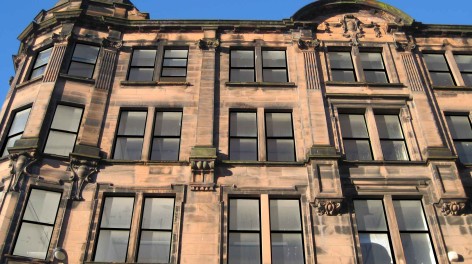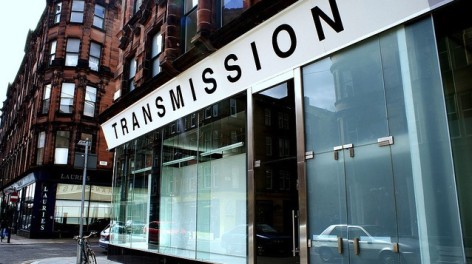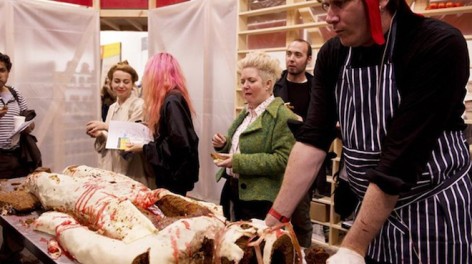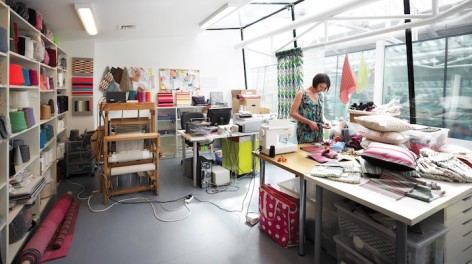Showing posts with label April 2014. Show all posts
Showing posts with label April 2014. Show all posts
Thursday, 24 April 2014
Tuesday, 8 April 2014
Le Swimming
The underground car park, a relatively recent addition to the abundance of art spaces in Glasgow, has undergone a transformation, starting with a coat of pale blue paint on the walls.
"A disused underground car park under a modern tower in Glasgow’s City Centre imagines it was a swimming pool in an alternate history. Subverted through a vision of a past non-existent utopia, the car park becomes a doorway to another world, twice removed from its current status of abandonment. Artists Nadège Druzkowski, Sukaina Kubba, Jenny Lewis, Philippe Murphy, Alys Owen and Beth Shapeero transform this space into a body of a swimming pool, with works that explore the idea of ‘Other Spaces’ on the one hand, and react to the transformation of the car park on the other.
The introduction of a fictional past (swimming pool) to an existing heterotopic space (underground car park) harkens to the utopian origin of modernist residential towers, where open spaces freed up by the piling up of apartments, were envisioned as spaces of leisure and recreation. The abandoned car park highlights the abandonment of otherwise profitable urban spaces due to the current economic conditions; while the fictional pool is both a comment on the lack of non-commercial public spaces in the city centre, and the dissolution of the follies of modernist housing."
Unfortunately I was unable to attend the opening of the exhibition so missed the performance that was part of Philippe Murphy's work. There were, however, hints of what went on.
Three plastic chairs were positioned on the boundaries of the 'swimming pool', with a whistle left on each of the seats.
The performance involved six lifeguards, three of whom sat at each of the chairs, and the remaining three circulated the perimeter of the room scanning for any emergencies. In this exhibition context, an emergency situation was, for instance, when someone got too close to an artwork, or started to touch the work. Such an occurrence prompted the lifeguard-come-invigilator to blow their whistle, which in turn prompted the other lifeguards to blow their whistles (each of which was a different pitch). What a good way to deter people from touching the artwork.
Beth Shapeero's sculptures certainly tempt the viewer to touch. Three huge vats are filled with three different liquids, industrial paint, varnish and household gloss.
A skin-like layer had formed on each of the surfaces, in the same way that a crust forms on a bowl of custard.

Sunday, 6 April 2014
Monday, 31 March 2014
Guide to Glasgow International
A weekend in Glasgow, at Glasgow International






Transmission Gallery (courtesy Merchant City Marketing); artist Angharad Mclaren & South Block (both courtesy South Block); Bedwyr Williams and Transmisson cafe (both courtesy Transmission)
Glasgow has long had the edge when it comes to contemporary art. Our guide to its biennial festival, and the places to eat, drink and shop en route, ensures you make the most of both the art and the city.
The Glasgow International map features 53 separate sites, dotted around the city centre’s regimented street grid and edging out in all directions to the more unruly suburbs. This biennial festival of contemporary art infiltrates the city’s existing (and extensive) art infrastructure and adds a wealth of new, temporary venues and public sites for its 18 days.
Now in its sixth edition – and the first under new director Sarah McCrory – Glasgow International is both in and of the city. Shows by visiting international artists rub shoulders with exhibitions from equally well-travelled locals, and the sense of the city’s healthy cultural confidence is palpable.
For your visit to GI, start on Osborne Street at the Festival Hub in South Block, home to artists studios, creative businesses and All That Is Coffee – an artisan espresso outlet that also knows its way around a good cup of tea and a chai latte. Here you’ll find yourself within striking distance of some of Glasgow’s best independent bars, cafes and – of course – gallery spaces. A short walk up Osborne Street there’s The Modern Institute, for example, a commercial gallery with a 40-strong roster of artists that includes four Turner Prize winners. For GI, the gallery is hosting group show, Life & The Invitation& Vapour in Debri&.The Modern Institute’s other space nearby on Aird’s Lane is showing New York-based artist Anne Collier.
The singer looks much as he did in the 1980s. Must be the healthy Glasgow lifestyle.
While you’re in this part of town, you should also visit the artist-run Transmission Gallery on King Street – showing Puerto Rico’s Beatriz Santiago Muñoz – and its neighbours Street Level Photoworks (Latvian artist Arnis Balcus and the Netherlands’ Johan Nieuwenhuize) and Glasgow Print Studio (Glasgow artist Alex Frost). The Print Studio has an easy to browse shop with a fantastic collection of new and archive prints by Scottish and international artists.
Ready for a break? Get yourself to Once Upon A Tart on the opposite side of the street, a kitchen and bakery where you can indulge in home-baked treats of the sweet or savoury kind. If it’s alcohol you’re after, then try Mono, a bar and gig venue that serves vegan food and – curiously and brilliantly – has a record shop attached to it, run by the singer in legendary Glasgow indie band The Pastels. He’ll most likely be behind the counter, sifting through vinyl and looking pretty much as he did in the 1980s. Must be the healthy Glasgow lifestyle.
Where now? Further east, perhaps, to Charlotte Street where Hardeep Pandhal presents Jojoboys, a series of lamppost banners that explore the history and visual identity of Camp Coffee. (The factory that first made this coffee substitute, originally created in 1885 for Scottish soldiers in India, once stood on the street.) There’s more to see in the East End, such as the David Dale Gallery (showing Swiss artist Claudia Comte), but the other main cluster of GI activity is to the west of the city centre on Sauchiehall Street. Head on foot along Argyle Street, turn right onto Queen Street, and be sure to stop off on your way at GoMA (Gallery of Modern Art). Housed in a neo-Classical building built in 1778, it is showing the first major UK solo exhibition by Berlin-based Alexsandra Domanovic, as well as work by Modern Institute artist Sue Tompkins.
Now continue west towards Buchanan Street, where Glasgow comes to shop for shoes, clothes and all things Apple. If you’re in need of (more) good coffee, check out local chain Tinderbox, either in the upmarketPrincess Square shopping centre or back east along Ingram Street, described by Glasgow’s marketers as “the city’s most exclusive fashion boulevard”. Which means Jigsaw, Ralph Lauren, Mulberry and a nearby Armani store.
At the top of Buchanan Street, turn left onto Sauchiehall Street by the Royal Concert Hall. A short walk will take you to McLellan Galleries, which has been brought out of its slumber for GI. Built in 1856 and now rarely used, it is hosting video work from Jordan Wolfson, paintings by Avery Singer, sculptural and audio-visual installations from Glasgow-based Charlotte Prodger, and a retrospective of Hudinilson Jr, the Sao Paulo-based artist who died earlier this year.
There’s another retrospective – this time of Palestinian artist Khaled Hourani – at the nearby Centre for Contemporary Arts (CCA), as well as work by the four artists shortlisted for the Jerwood/Film and Video Umbrella Awards. With its airy indoor courtyard café, performance spaces and the Welcome Home craft and design store, CCA is a good place to linger. It’s got a great bookshop, too.
To the rear of CCA, you’ll find the Charles Rennie Mackintosh-designed Glasgow School of Art (showing Michael Stumpf’s wittily-observed sculptures), and opposite it you can’t miss the brand new Reid Building, clad in frosted glass panels and glancing knowingly at Mackintosh’s 1909 masterpiece.
There’s more to take in heading west, from Simon Martin at the Kelvingrove Art Gallery and Museum to the foodie delights of the bars and restaurants on the Finnieston stretch of Argyle Street – tryCrabshakk, where super-fresh seafood is handled with care, served with understated style and has even won the praise of Observer food critic, Jay Rayner.
Jump in a car or taxi now and head to the South Side – over the Clyde toTramway on Albert Drive, which is showing three decades of work by American video and performance artist Michael Smith, along with a new commission from Welsh artist Bedwyr Williams. Further south, the disused Govanhill Baths features inflatable sculptures by Anthea Hamilton and Nicholas Byrne, and there’s more work on show at the artist-run Queens Park Railway Club. And with a name like that, how can you resist paying a visit?
Glasgow International is nearly here - time to get planning!
Glasgow International 2014: Inflatable art, nail bars & dystopian visions in Scotland’s creative capital
Centre for Contemporary Arts (CCA), Glasgow, Scotland, 4 April 2014–21 April 2014
Posted by Susie Stubbs 25 March 2014
http://www.creativetourist.com/articles/art/scotland/glasgow-international-2014-inflatable-art-nail-bars-dystopian-visions-in-scotlands-creative-capital/

Bedwyr Williams, ‘The Starry Messenger' (still), 2013. Courtesy the artist, MOSTYN, Oriel Davies & Arts Council of Wales
As Glasgow gears up for its biennial festival of visual art, we publish aguide to the city, and an overview of a festival considered by some to be the best in Britain.
Glasgow International may be one of the world’s younger visual art festivals, but in the years since this particular biennial baby launched in 2005, it has secured the attentions of critics, artists and the culturally minded from across the globe. The Guardian’s notoriously hard to please Adrian Searle reckons it’s the country’s best such fest; critic Laura Cummings praised it for its “openness, involvement and honest directness”.
One of the reasons Glasgow International has risen through the ranks so quickly is that it hasn’t been conjured out of thin air. Like Liverpool Biennial, it’s based on a homegrown and artist-led arts scene, one that just happens to have international credibility. And while it doesn’t hurt that GI is held in one of the most interesting cities in Europe, another reason it works is thanks to its efforts to push the boundaries of what is commonly considered “visual art”. So, the last event saw a focus on live and immersive artworks – Jeremy Deller’s Sacrilege, a bouncy castle version of Stonehenge, for example, or artists at the Mitchell Library masquerading as librarians – and it also saw a spike in the numbers of giddy, bouncing-up-and-down art lovers who attended.
It doesn’t hurt that GI is held in one of the most interesting cities in Europe
The focus this year is no different. Although the 18 day festival is headed up by a new director (Sarah McCrory, formerly of Frieze Projects), and although it takes over all of the city’s mainstream museums and galleries, the trend for immersive, innovative art continues. Bedwyr Williams creates a dark and disturbing installation at Tramway, a life-size vision of a world corrupted by greed and status symbols, Alistair Frost runs a nail bar from a disused shop unit, and a group exhibition atSWG3 Gallery sees artworks tumble from the frames that normally constrict them.
Anthea Hamilton and Nicholas Byrne, meanwhile, bring back the inflatable art, this time via a series of pin-shy sculptures that fill a disused, historic swimming baths, and Play Summit, led by artist Nils Norman, relocates an adventure playground to Glasgow Green, with a series of parallel talks and demos lined up to tackle the issue of child’s play (areas) in cities.
With fifty exhibitions, there is much at this year’s Glasgow International to get to grips with, in a city that we have long turned our envious eyes towards – which is why we have published a guide to both the festival and the city it calls home. Written by the Glasgow-based art writer, Chris Sharratt, it provides a handy route around the events that make up Glasgow International, with recommendations of places to eat, drink and shop along the way. And with all artistic eyes about to turn on Glasgow, and with Easter’s Bank Holidays looming large, now is the time to book a trip.
Thursday, 20 February 2014
ATELIER PUBLIC#2
As the launch of Glasgow International (Gi) Visual Art Festival draws closer, one exhibition that is part of the Gi programme is about to open.
ATELIER PUBLIC#2
GoMA
20 FEBRUARY – 27 MAY 2014
20 FEBRUARY – 27 MAY 2014
ATELIER PUBLIC#2 is a re-presentation of a 2011 exhibition at GoMA where members of the public were invited to make artworks using materials available in the gallery. In the spirit of ATELIER PUBLIC, visitors are invited to use the materials to make new work, which will be installed in the gallery for other visitors to see. These materials may change over the course of the 13 weeks the exhibition is open, and the works may be used by others as part of their creative and playful practice in the studio. As in 2011, some artists have been invited to work within the parameters of the framework of ATELIER PUBLIC#2 and develop the installation.
There are a number of events scheduled for the duration of the exhibition, and more information can be seen at: http://atelierpublic.wordpress.com/how-to-participate/events/
The hashtag for Twitter, Vine, Instagram, and You Tube is #ATELIERPUBLIC, and you can follow us @GlasgowGoMA
I look forward to seeing the changing elements and creations throughout this exhibition, and am interested to see how the public interact with the work and embrace the invitation to contribute to the exhibition.
Subscribe to:
Posts (Atom)









